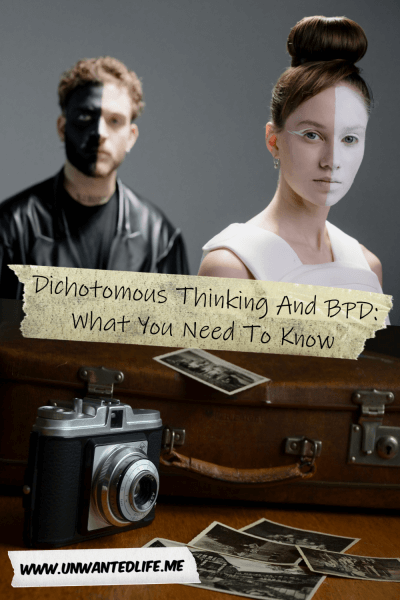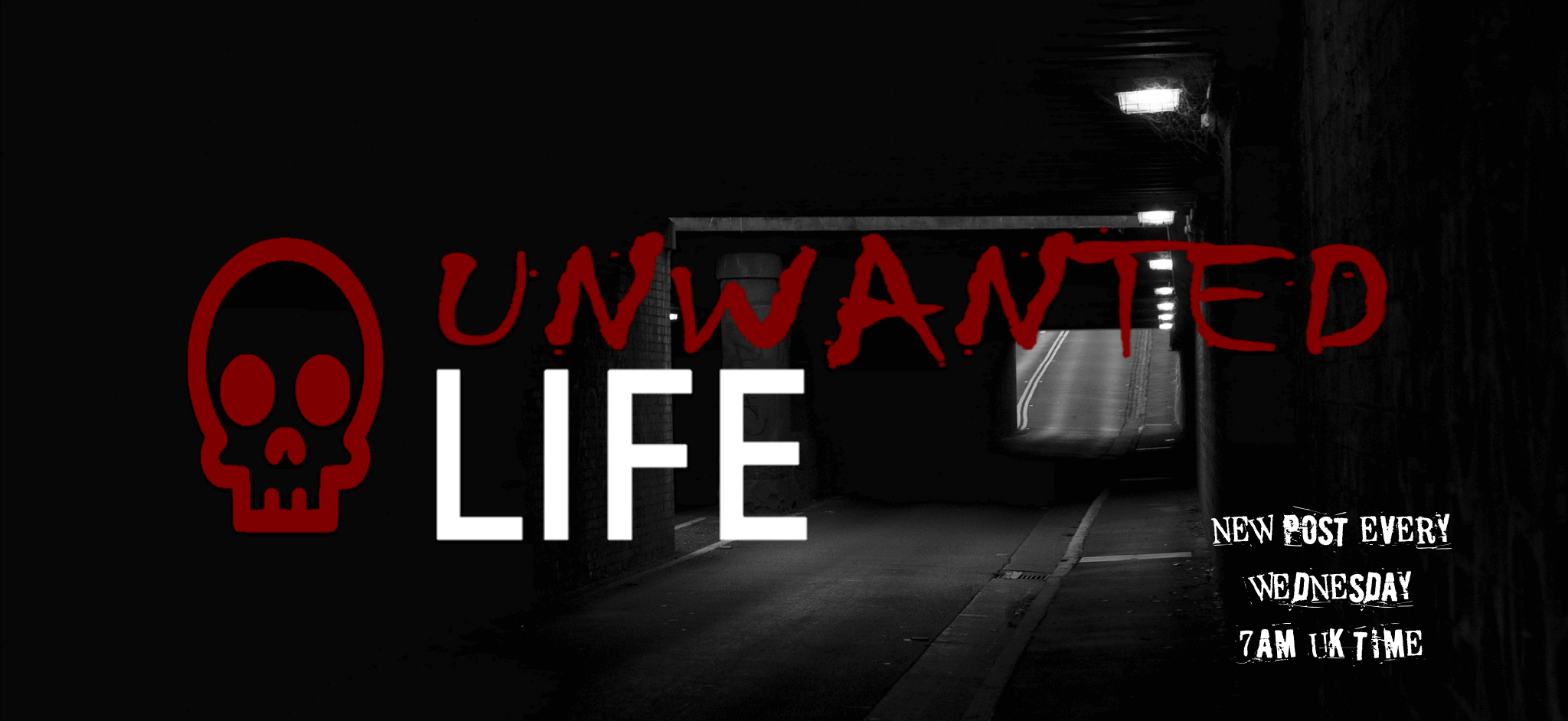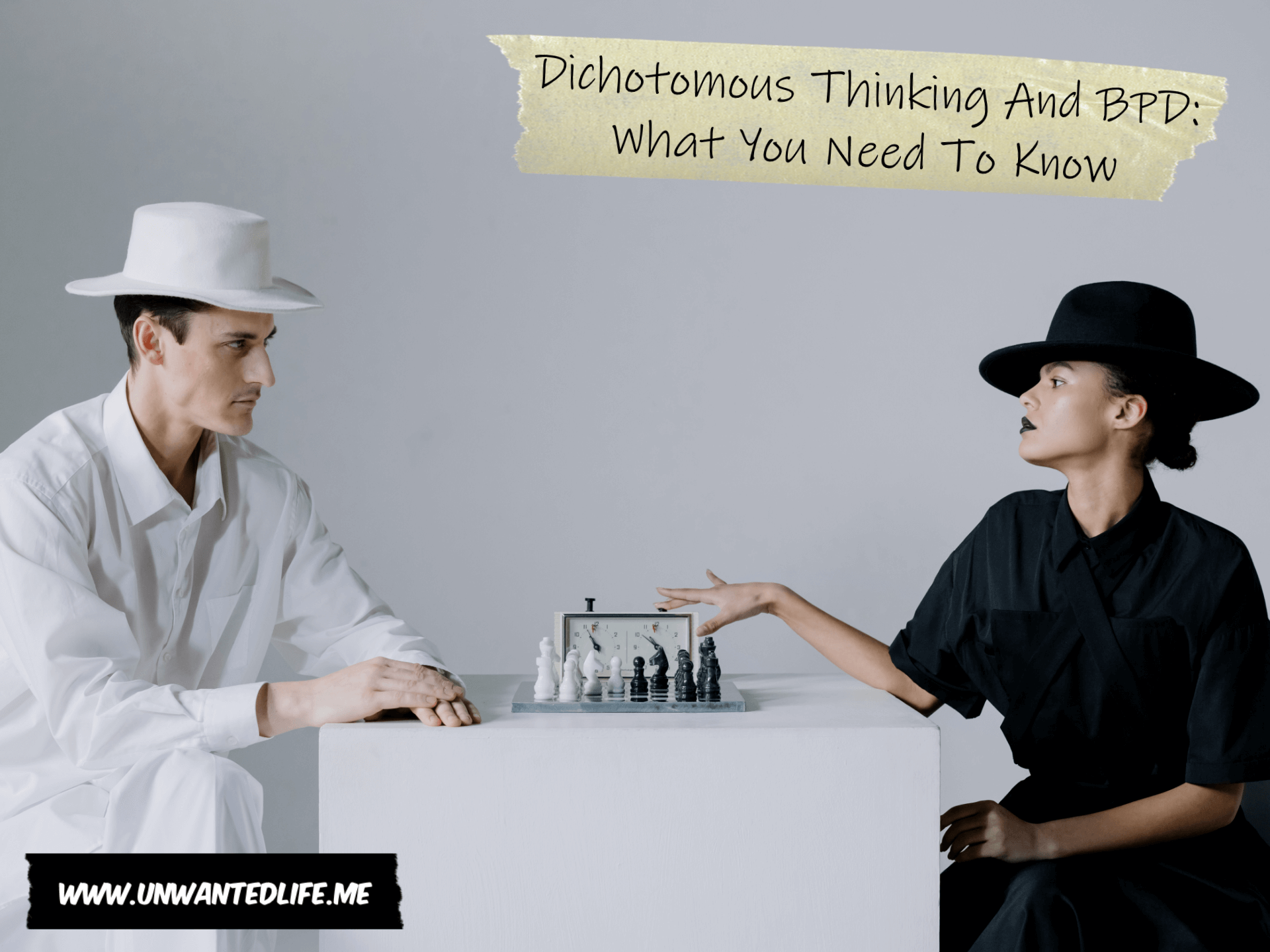I saw the picture below about dichotomous thinking and I was inspired to write this article as I started to think about my own borderline personality disorder (BPD) and thinking errors. I wanted to know just how true this picture was as I started to question my own diagnosis of BPD.

What Is Dichotomous Thinking?
If you read my article on thinking errors then you may be familiar with dichotomous thinking by the thinking errors name that I’d given it, ‘all or nothing thinking’. If you haven’t read it (then why not read that article after this one), then here’s a handy definition for you if the image above still left room for confusion.
According to the APA, dichotomous thinking is where we think in extreme polar opposites, such as good or bad, black or white, right or wrong, and without considering anything and everything else in between these two extremes.
How Do You Know If You’re A Dichotomous Thinker?
Try looking back at your thoughts, or monitor your thoughts over the next few weeks, and see if there’s a pattern to your thinking, whereby words like the following appear:
- Never.
- Always.
- Perfect.
- Disaster.
I know ‘always’ and ‘never’ come into my thinking a lot, like “My health is never going to get better” or “Why’s it always me?”. But if you stop for a second to think about it, it isn’t always you, it’s just you twisting a feeling that it feels like it’s always you, into a fact, but it’s fake news. Same with my thoughts on my health.
My health ebbs and flows, where I have good days, bad days, and days in between, but it has been worse than it is right now. When my heart palpitations first started, it felt like someone was kicking the inside of my ribcage with every. Single. Heartbeat. It was not only painful, but debilitating, but then I started on beta-blockers and now it’s extremely rare for my palpitations to be a problem.

How Can Dichotomous Thinking Hold You Back?
Dichotomous thinking can stop you from learning and hold you back. If you think you’re not good at something, then you won’t see a reason for trying to become good at it. This kind of thinking can also stop you from learning something new or pursuing new and better career options.
What’s worse, it could lead to the development of an eating disorder if you apply dichotomous thinking to food. If you saw all food as good or bad, clean or dirty, healthy or unhealthy, then you could end up limiting your food options. This kind of dichotomous thinking is a factor in the development of orthorexia.
Dichotomous Thinking And BPD
Dichotomous thinking isn’t indicative of any mental health condition, because we can all think in black-and-white terms, but it does appear to also be a characteristic of BPD. It’s likely that dichotomous thinking is common among people with BPD because of how their BPD developed. BPD usually develops as a result of abuse, which could be physical, sexual, or neglect during childhood, losing a parent while young, or being brought up around people with addictions (Mayo Clinic). In short, a childhood that’s especially stressful.
According to Verywell Mind, people with BPD are prone to have problems with how they think, whereby these problems cause issues with their relationships, emotions, and impulse control. Dichotomous thinking isn’t a thinking error, per se, unless it’s the only way you think. Although this thinking style is a style of thinking that sees things in binary terms, like black or white, this thinking style can be useful when quick decisions are required (Oshio, 2012).
However, Pompili, Girardi, Ruberto, and Tatarell (2005) found that suicide was more prevalent among those with BPD than the general population after conducting a meta-analysis comprising 1179 BPD patients. Thus, it doesn’t take that much of a stretch of the imagination to see how a high suicide rate and ‘all or nothing’ dichotomous thinking present a worrying problem for those of us with BPD. Impulsivity is a characteristic of BPD and a factor in suicidal behaviour for a reason (Brodsky, Malone, Ellis, Dulit, and Mann, 1997).
Verywell Mind claims that people with BPD can struggle to see the complexity in situations and people, and are unable to see the grey area between perfect and horrible. Furthermore, Verywell Mind claims that people with BPD can slip from one side to another in their extreme views, whereby you can think your partner is the best person in the world one day and the next that they’re the devil.
Two Kinds Of Dichotomous Thinking
After conducting a study, Veen and Arntz (2000) proposed an interesting idea about dichotomous thinking in people with BPD. They propose that there were two kinds of BPD dichotomous thinkers, a unidimensional and multidimensional dichotomous BPD thinker.
So what is unidimensional and multidimensional dichotomous thinking? Well, according to Veen and Arntz (2000), if you had unidimensional dichotomous thinking you would make extreme evaluations that, for example, would lead to a person being seen as either “all good” or “all bad”.
However, with multidimensional dichotomous thinking, those same kinds of extreme evaluations may not lead to an “all good” or “all bad” view of a person. Therefore, with multidimensional dichotomous thinking, you can see someone as being completely reliable while thinking they have zero self-confidence without having to put them in the “all good” or “all bad” box.
Veen and Arntz (2000) reached this dual view of dichotomous thinking after performing a study on three groups of participants. The three groups were those with BPD, those with Cluster-C personality disorder as a control, and a secondary control group of those without a personality disorder. The three groups had to watch a series of videos, whereby the BPD-specific videos elicited extreme evaluations from the BPD group, but for the control videos, there was no difference between the groups. Thus, the study highlighted how people with BPD don’t always think in rigid black or white.
If what Veen and Arntz (2000) found is true, that would mean that what Verywell Mind had claimed about people with BPD being unable to understand the nuances of life would be incorrect. Certainly, for me at least, what Veen and Arntz (2000) found reflects my issues with BPD. I’m aware that in certain aspects of my life, I can see things in simple binary ways. I certainly did when I was recklessly impulsive, self-harming, and made attempts to take my own life. However, I’m also fully capable of understanding and seeing the multitude of colours between the black and white.
So it would seem that I needn’t have questioned my diagnosis because of the image that sparked this article.
As always, leave your feedback in the comments section below. Also, feel free to share your experiences of dichotomous thinking and BPD in the comments section below as well. Don’t forget to bookmark my site and if you want to stay up-to-date with my blog, then sign up for my newsletter below. Alternatively, get push notifications for new articles by clicking the red bell icon in the bottom right corner.
Lastly, if you’d like to support my blog, you can make a donation of any size below. Until next time, Unwanted Life readers.
References
Brodsky, B. S., Malone, K. M., Ellis, S. P., Dulit, R. A., & Mann, J. J. (1997). Characteristics of borderline personality disorder associated with suicidal behavior. American Journal of Psychiatry, 154(12), 1715-1719. Retrieved from https://doi.org/10.1176/ajp.154.12.1715 and https://ajp.psychiatryonline.org/doi/full/10.1176/ajp.154.12.1715.
Oshio, A. (2012). An all‐or‐nothing thinking turns into darkness: Relations between dichotomous thinking and personality disorders 1. Japanese Psychological Research, 54(4), 424-429. Retrieved from https://onlinelibrary.wiley.com/doi/full/10.1111/j.1468-5884.2012.00515.x and https://onlinelibrary.wiley.com/doi/pdf/10.1111/j.1468-5884.2012.00515.x.
Pompili, M., Girardi, P., Ruberto, A., & Tatarelli, R. (2005). Suicide in borderline personality disorder: a meta-analysis. Nordic journal of psychiatry, 59(5), 319-324. Retrieved from https://www.researchgate.net/profile/Maurizio-Pompili-2/publication/7026467_Suicide_in_borderline_personality_disorder_A_meta-analysis/links/004635156e83c4b797000000/Suicide-in-borderline-personality-disorder-A-meta-analysis.pdf, https://doi.org/10.1080/08039480500320025, and https://www.tandfonline.com/doi/abs/10.1080/08039480500320025.
Veen, G. & Arntz, A. (2000). Multidimensional Dichotomous Thinking Characterizes Borderline Personality Disorder. Cognitive Therapy and Research, 24(1), 23-45. Retrieved from https://www.researchgate.net/profile/Arnoud_Arntz/publication/226716303_Multidimensional_Dichotomous_Thinking_Characterizes_Borderline_Personality_Disorder/links/00b4952cd24170c512000000.pdf.


This was a very interesting article! I had heard of BPD before in one of your posts, but never about dichotomous thinking. Now reading about it makes me think a lot about past experiences and way of thinking all black and white in the past. Thank you for sharing your experience!
It’s a really common way of thinking, especially if you’re feeling down
Wow! I loved reading this to be honest. Before now, I have never heard of Dichotomous thinking and so I found this post fabulous as well as informative. I agree that Dichotomous thinking can stop you from learning and hold you back. I never knew about Dichotomous thinking before now and so I have never really paid attention to whether my thoughts are Dichotomous or not. I’ll definitely start paying attention to that so I can make necessary corrections. Thank you for sharing
I hope this knowledge will help improve your mental wellbeing going forward
Unfortunately, I do fall into this category, at least I tend to. Dichotomous thinking is not ideal and I plan to research further. Thanks for the links!
Happy researching
I’ve read that certain temperament types have a tendency to this kind of thinking.
It’s certainly common among those with depression
I had not heard of this before but not thinking about I believe that I have thought like this in the past. There has been many times that I would just not doing thing because I feel like I won’t be any good about it. I feel like this type of thinking can really hold someone back.
Indeed it can. Thanks for sharing
One of my closest friends has BPD and dichotomous thinking is definitely common for him. This has helped me understand him a bit more, so thank you!
I’m glad I was able to help
Love to learn more about BPD…and I wasn’t disappointed. Learned a lot. I find it very interesting. I agree with your paragraph on ‘always’ and ‘never.’ Thanks for sharing!
http://www.lifebeginsattwenty.com
Thanks for reading
I learned a lot from reading this especially about BPD. Thank you
Thanks for reading
I love reading your posts – easy to read yet so informative. Two points:
1. “ just you twisting a feeling that it feels like it’s always you, into a fact, but it’s fake news.” I love this quote!
2. Multidimensional Dichotomous Thinking – I had never heard of this. This is really helpful for me understanding a loved one. She is very dichotomous thinking, very black and white, but then she has these interesting layers of extreme ideas. MDT is a great way to understand her thought style, especially when it comes to her understanding of people.
I’m glad you liked it and it increased your understanding
This was a really interesting read. As someone who has struggled with dichotomous thinking fueling body dysmorphia and an eating disorder in the past, I am all too familiar with the way that it can impact your life. However, I’ve never heard of multidimensional dichotomous thinking before. There were always aspects of this black and white thinking that didn’t fit with how my head worked but I couldn’t make sense of that given that it did fit so well in other ways. However, the way that you describe multidimensional dichotomous thinking here explains SO much!
Multidimensional dichotomous thinking really helps fill in the gaps doesn’t it. I’m glad it helped you to learn about it from my article
This was really useful and interesting.
Thank you
BPD is easily misunderstood, and many people really don’t understand it. I didn’t know dichotomous thinking was a part of the condition until now. Thank you for such an informative and well thought out post.
Thanks for commenting
very well written post and very helpful. Got me thinking about black and white thinking and its possible origins.
Thank you. I’m glad it’s got you thinking
Really informative and interesting post! I did not even know that there was a special term for this kind of thinking. I know that my way of thinking is not black and white but your article helped me understand the extension of the black and white way of thinking.
Thank you for sharing ?
I’m glad I was able to help build your knowledge
What an interesting post! I’ve never heard of BDP or dichotomous thinking before. It makes me wonder how many people I’ve encountered in my life who thought like this that might have this disorder, and I guess after reading it would help in understanding why they think the way they do a bit more.
Like they say, you never really know what people are struggling with
I’ve been through something like that. I truly understand the feeling when asking “Why is it me?” but it’s not you or me. I think it’s how life is.
Indeed
Informative article.
Thank you
Nice blog!
Do visit to my blog and follow it if you like.
Thank you